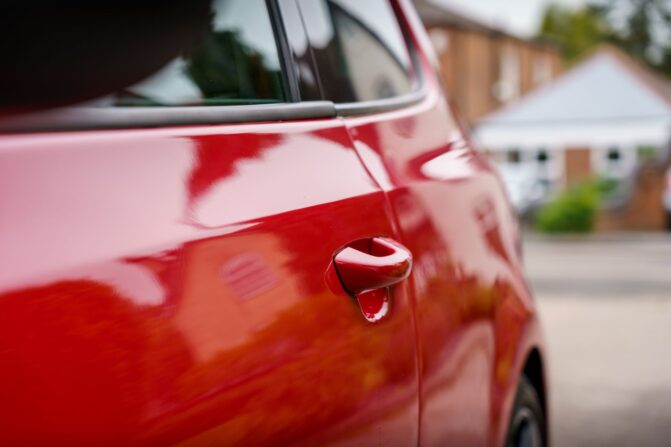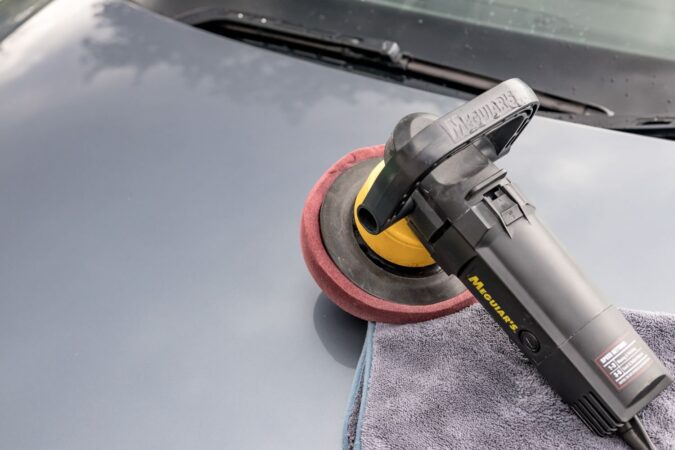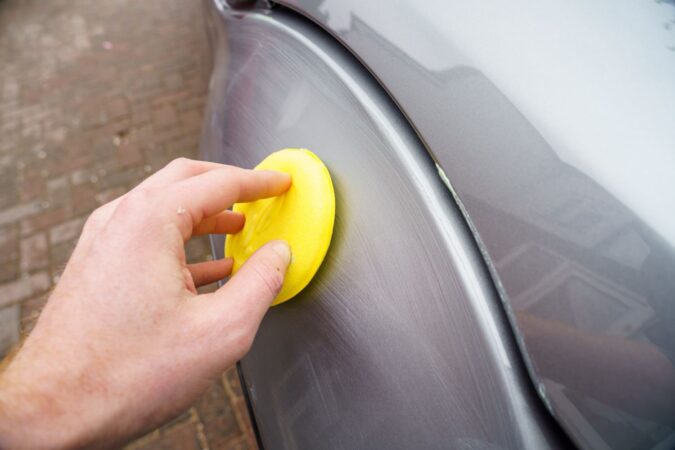Many of you visiting a car dealership lately might be wondering if PermaPlate is a ceramic coating. The short answer? No – PermaPlate is more like a sealant than a ceramic coating. So, while car dealerships and showrooms often market PermaPlate as a high-end paint protection solution, its durability and performance differ from actual ceramic coating.
One thing to note is that PermaPlate isn’t a product type or category, but a brand name. As a company, PermaPlate specializes in automotive paint and surface protection, such as tires, windshields, bodywork, paintwork, and even theft! They even offer interior protection. Additionally, many car dealers work with PermaPlate to offer extra protection for your new car.
This usually adds an extra $600 or so on top of a car’s sticker price just to have PermaPlate installed. However, if you’re expecting PermaPlate to be a super-strong and durable layer of ceramic coating, the answer isn’t so straightforward. If anything, as we mentioned earlier, PermaPlate is more like a sealant than a ceramic coating, though it’s not really made clear.
PermaPlate vs Ceramic Coating – How Do They Differ?
The first thing to bear in mind is how ceramic coating works. Ceramic coating is a chemical made from silica dioxide that you apply to a car’s body. This extra layer on top of your car’s paint will protect it from minor scuffs and dents. It protects the car from stone chips, scratches from improper washing, and sometimes, very minor scrapes from other cars.
Generally speaking, ceramic coating is one of the best forms of paint protection that you can get for your car. However, it’s also one of the more expensive alternatives. On the other hand, with PermaPlate, it’s hard to find data on whether it really is a ceramic coating or not. Neither their website nor car dealers specify that it’s a ceramic coating or if it’s just wax.
For all we know, based on what we could find, PermaPlate appears to just be a normal sealant. The latter doesn’t last nearly as long, nor is it as durable, as a proper ceramic coating. Judging by the way it’s applied too, PermaPlate is most likely a polymer sealant. Regardless, is it even worth the hefty $600 premium when getting it installed at the car dealership?
Well, most car dealers charge $600 for PermaPlate protection for the interior, windshield, and paint protection, and there’s often a warranty attached. All in all, sounds like a good deal, right? However, there’s a lot of skepticism about how much protection PermaPlate offers. Granted, it ought to offer at least a bit more protection than not having it installed at all.
A Closer Look At PermaPlate vs Ceramic Coating
Now that we’ve established that PermaPlate is not a ceramic coating and that it’s more of a sealant, what is PermaPlate, exactly? PermaPlate, as a brand, positions itself as a premium automotive protection product. In short, they offer protection solutions for paint, fabric, leather, and even windshield protection.
PermaPlate’s paint protection formula is specifically designed to shield your car from UV rays, oxidation, bird droppings, and environmental contaminants. Based on their own marketing literature, here’s what PermaPlate claims they could offer you:
- UV and Oxidation Resistance – It protects your car’s paintwork against sun damage and fading.
- Hydrophobic Properties – Moreover, it repels water and contaminants, making cleaning your car easier.
- Scratch and Stain Resistance – It also reduces the likelihood of minor surface scratches and chemical stains.
For interior protection, PermaPlate even offers treatments that claim to prevent stains, cracking, and fading on fabric, leather, and vinyl. Then, there’s their windshield protection, as it’s formulated to reinforce your windshield’s glass integrity and reduce the risk of chips and cracks.
Third-Party Testing And Expert Opinions
However, do PermaPlate’s claims hold true? We already know that PermaPlate is not actually the same as ceramic coating, so what else should you know? Mainly, how well do they perform? Some detailers and industry professionals have compared PermaPlate to standalone ceramic coatings, with mixed results. Here’s what they have to say:
- Durability – While PermaPlate provides noticeable short-term protection, many professional detailers argue that high-end ceramic coatings (such as Gtechniq or CQuartz) offer superior long-term resilience. So, it might be worth your upgrading straight to ceramic coating.
- Application Process – Unlike professional ceramic coatings, which require precise preparation and curing time, PermaPlate is often applied at the dealership, raising questions about consistency in application quality. There are times when poor installation might cause issues down the line.
- Real-World Performance – Some users and experts also report that the beading and hydrophobic effects last a few months. On the other hand, others claim that the coating diminishes faster than expected, so we don’t have consistent data as of yet.
Based on our research of what real owners have to say about their cars with PermaPlate coating, their feedback does depend on expectations as well as the quality of the application. Many owners that we’ve spoken to praise the convenience and ease of PermaPlate. However, they’re also wary that PermaPlate’s paint protection doesn’t last as long as expected.
PermaPlate vs Ceramic Coating Warranty Coverage
Moreover, there are other owners out there who have reported difficulty with claiming PermaPlate’s warranty for damage, with odd exclusions or strict maintenance requirements. All in all, while PermaPlate does provide a decent level of protection, their paint protection products can’t match the durability of proper ceramic coatings.
Speaking of, one of PermaPlate’s key selling points is its included warranty coverage. We’ve found that dealerships typically use this to justify its extra cost. Here’s what this warranty covers:
- Paint Protection Warranty – Covers fading, oxidation, water spotting, bird droppings, tree sap, and insect damage. It may also include minor surface stains from fuel or other environmental contaminants.
- Interior Protection Warranty – Covers stains from food, drink, ink, dye transfer, and pets. For leather and vinyl interiors, it may also cover cracking, fading, and sun damage.
- Windshield Protection Warranty – Covers repair or replacement of minor chips and cracks caused by road debris. However, exclusions may apply for large or spreading cracks.
As we mentioned earlier, strict limitations and exclusions are the bane of many owners trying to claim the warranty. Some of them include proving that you regularly maintain and take good care of your car. Additionally, there are damage exclusions, so it may not cover deep scratches, rock chips, or damage caused by improper washing techniques.
Is PermaPlate Worth It vs Ceramic Coating?
PermaPlate, despite some of its shortcomings, can still be worth it for the right person. As such, we could recommend it for those of you who prefer a dealership-backed warranty and want a low-maintenance protection solution. Otherwise, if you want the best long-term paint protection or if you need a more affordable product, it’s wise to look elsewhere.
If you’re still not sure, though, we’ve prepared this handy little table to compare PermaPlate, ceramic coating, as well as cheaper paint sealants:
| Feature | PermaPlate | Ceramic Coating | Paint Sealant |
|---|---|---|---|
| Durability | 3–7 years (varies by warranty) | 2–5 years (pro-grade); DIY: 6–24 months | 3–12 months (depending on product) |
| Protection | Resists fading, oxidation, and minor stains | Strong hydrophobic properties, UV protection, and minor scratch resistance | Enhances gloss, and it protects against dirt and contaminants |
| Scratch Resistance | Low – primarily protects against fading and stains | Moderate – resists minor scratches and swirl marks | Low – no real scratch resistance |
| Hydrophobicity (Water Repellency) | Moderate – resists water spots but wears down over time | High – repels water, dirt, and grime effectively | Moderate – helps with water beading but fades over time |
| Ease of Application | Dealership-applied (no DIY option) | Pro application recommended; DIY available | Easy DIY application |
| Maintenance | Requires occasional reapplications for warranty validity | Requires special pH-neutral soaps; no waxing needed | Needs frequent reapplication for lasting protection |
| Warranty Coverage | Yes – covers stains, fading, oxidation, and minor damage | Some pro-grade coatings offer warranties | No official warranty (varies by brand) |
| Cost | $500–$2,000 (dealership pricing) | $500–$2,500 (pro), $50–$200 (DIY) | $20–$100 per bottle |
| Best For | New car buyers looking for a dealership-offered protection plan | Car enthusiasts seeking long-term protection with minimal upkeep | Budget-conscious users looking for short-term gloss and protection |
| Cons | High cost, limited warranty coverage, no scratch protection | Expensive upfront, professional application recommended | Short lifespan, needs frequent reapplication |
What Other Types Of Paint Protection Are There?
So, what’s our recommendation on whether or not you should take up your car dealer’s offer to install PermaPlate? Well, if the dealer applies it for free, that’s great! We all like free things. And, it helps to protect your car. But if you have to pay extra, we recommend that you stay away from it. Instead, get protection later on from an auto detailer.
Personally, I find it hard to justify the $600 upcharge by the dealer just to have PermaPlate installed, which offers a sufficient level of protection, but not overwhelmingly so. Therefore, if you want to install aftermarket paint protection on your car from a professional auto detailer, here are some other good alternatives, instead (varying in costs and the protection they offer):
1. Wax
Wax is the simplest and cheapest protection for your car. However, it only prevents dirt and grime from sticking to the car’s paint. The benefit is that you don’t have to wash it very hard to clean it, and it minimizes the chance of swirls and scratches from washing. However, typical car wax doesn’t protect your car from deep scratches and stone chips on the paint.
Another downside is that they last no more than three months. Depending on how you treat your car and how you wash it, it may last shorter than that. So, you’ll need to reapply them quite often. Still, this is a great—and cheap—option if you want to make your car look shiny and brand new while protecting it from dirt and grime. It costs between $60 to $150 on average.
You can go to an auto detailer or a car wash and get a wax job, so it’s relatively accessible. Note that the cost depends on the car size, so larger cars will likely be on the higher end of the spectrum. If you have the spare time, you could even apply car wax yourself. All you need is quality car wax such as from TurtleWax, clean microfiber towels, and an applicator pad.
2. Sealant
Sealant or paint sealant is a synthetic polymer that you apply to the car’s surface. PermaPlate is quite similar to this. Professional detailers will apply it by using a polishing machine or an applicator pad. Once the chemical cures, it bonds with the paint surface and forms a protective layer on top of the car’s paint to protect it from dirt, scratches, and scuffs.
You’ll notice that they’re similar to ceramic coating, in the sense that they create a protective layer. Hence, the mass confusion with PermaPlate. However, the application method is different. And, ceramic coating is harder and more durable, meaning it lasts longer and offers better protection. That being said, sealant will offer enough protection for most scenarios.
Additionally, auto detailers often offer how many layers of sealant you want to apply to your car. Most will apply two layers as standard, but you’ll usually have the option to pay extra and apply up to five layers. There are virtually no benefits to applying more than five layers. Auto detailers will charge between $200 and $600 on average, though it varies by car size.
The cost usually already includes the cost of polishing, paint correction, and other prep work. As for durability, sealants will last anywhere between six months to a year. This depends on the quality of the product and how many layers you apply. You can do this yourself to save money if you have a polishing machine, but this is a long and labor-intensive process.
3. Ceramic Coating
As noted earlier, ceramic coating is made from silica dioxide. Some auto detailers may also refer to it as glass or crystal coating. Additionally, some ceramic coatings may use nanotechnology to improve their hydrophobic quality and UV resistance. Auto detailers will call it nano-coating or nano-ceramic coating, and the application is slightly different from sealants.
Instead of using a polishing machine, you’ll need to apply it by using an applicator pad and then rubbing it onto the surface in a crosshatch pattern. Almost like you’re painting the car with a brush. As you’d expect, it’s a long, complex, and labor-intensive process. So, if you don’t have the time or energy, it’s best to just go to an auto detailer and have them do it for you.
The average cost for a ceramic coating is usually between $1,000 to $3,000. Yes, that’s a lot of money, and it’s the biggest reason why folks are skeptical about PermaPlate. But, ceramic coating usually lasts at least a year, and some products may last for up to three years before you need to reapply them. Although, some maintenance is necessary to achieve this.
There’s also a hardness level for ceramic coating, signified with an ‘H’. This varies from 1H to 9H, and 9H is the hardest of them all. How long they last still depends on the product quality, but the harder they are, the better they are at resisting scratches and scuffs. In most cases, ceramic coating is one of the best forms of paint and surface protection you can get.
4. Paint Protection Film (PPF)
Paint Protection Film or PPF is a clear urethane wrap for your car. It’s the same sort of material as a sealant, but you apply it as a wrap rather than applying it in wax or fluid form like you would with a sealant. Almost as if you’re putting a sticker on your car. If you’ve seen a car with a brightly-colored wrap, PPF is almost similar to that in its application.
However, car wraps are vinyl, whereas PPF is urethane. The advantage of PPF is that some of them have self-healing properties, where you can remove scratches by simply applying heat. PPF is quite expensive, it can be anywhere between $900 to $2,00,0 depending on your vehicle’s size. However, this cost usually already includes the cost of detailing your car.
The upside is that they can have a very long service life. Some brands will claim up to five or even seven years. But we think a more realistic estimate is around three years. Still, three years is a long period. Another benefit is that they require very little maintenance. Sealants and ceramic coatings will require maintenance spray at least every few months.
On the flip side, this isn’t necessary with PPF, although proper washing and waxing every three months are recommended if you want to keep it looking new and shiny. The biggest downside of PPF is that it can be prone to yellowing over time. Especially if you often leave your car under the sun, though this thankfully won’t affect the paint underneath it.
5. Nano Graphene Coating
Emerging onto the auto protection scene is nano-graphene coating, a newcomer. Made from carbon-based nano-structures, graphene coatings are believed to surpass even the protective qualities of ceramic coatings (this is also reflected in their price). This new entrant is known for its exceptional hydrophobic properties, leading to excellent water beading.
Furthermore, due to its tight-knit structure, the nano-graphene coating offers excellent resistance against chemical contaminants, UV rays, and even minor scratches. The distinct feature of this coating is its capability to dissipate heat quickly. This means on hot days, the car’s paint will remain relatively cooler. Applying it is similar to applying ceramic coatings.
Now, while it might be tempting to try a DIY project, for maximum benefit and assurance, a professional touch is recommended. Price-wise, it might be similar to, or a tad more expensive than, ceramic coatings, ranging from $1,200 to $3,500. Though costly, its longevity and resistance could justify the investment, promising protection for three to five years.
6. Hybrid Wax Coatings
A fusion of traditional car wax and modern sealants, hybrid wax coatings blend the best of both worlds. They offer the depth and warmth of a wax shine with the longevity and resilience of synthetic sealants (since PermaPlate is not a ceramic coating). These hybrid coatings have become popular recently as they tend to be easier to apply than more advanced products.
Yet, they still offer solid protection against common contaminants, minor scratches, and UV radiation. While they might not last as long as pure sealants or ceramic coatings, you can expect about 6-12 months of protection. Prices can vary based on product quality, but a high-grade hybrid wax-coating product will typically set you back just $20-$70.



